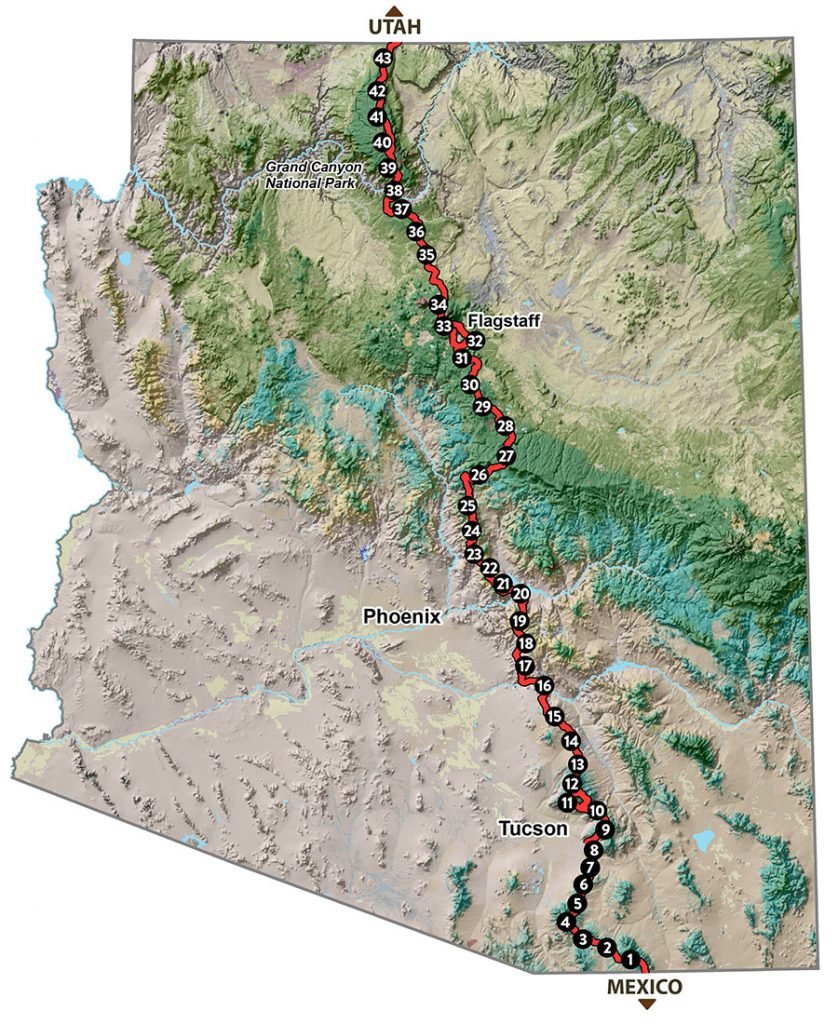Building a Resonant Lean-Agile Roadmap
By Gary Bamberger
Overview
Organizations must deal with unexpected impediments effectively to make progress on their Lean-Agile journeys.
In a previous article, I outlined the organizational assessment we use at Turning Point Coaching to understand the context of an organization on their lean-agile journey. This follow-up article will show how we leverage those responses to create a resonant quarterly roadmap that shows the possibilities for the organization. You can think of this as a unique trail map for the organization’s journey. And, just as with hiking, the roadmap is a living document that will be adapted to progress, impediments, and what is learned.
Below are examples of how the organizational assessment impacts the roadmap:
Arizona Trail Map
Executive Context
What is driving the change for the organization? For example, a roadmap for an organization whose primary goal is innovation will emphasize this in training, mentoring, and coaching, and the roadmap will include introducing innovation techniques. In comparison, a roadmap for an organization focused on improving throughput would emphasize lean and systems thinking techniques to remove waste.
What is the aspirational future-state vision? This involves envisioning how the organization will operate and what sets of practices the organization wants to include in the transformation (e.g. lean-agile, technical, DevSecOps, modeling, etc.). This vision, which aligns with the driver for change, is then shared with employees as part of the change management activities. Incremental updates are also shared.
What areas of the organization will be undergoing the transformation? For example, an organization that will pilot transformation activities on a smaller scale will have a far different roadmap compared to an organization that has many business units engaged. In addition, the roadmap must include engaging support groups like Human Resources, Accounting, Legal, Marketing, Sales, etc..
Who is sponsoring and supporting the transformation? Insights regarding which executives and leaders are engaged, supportive, aligned, and committed are key to building the roadmap. The roadmap will differ greatly between an organization where all executives and leaders are bought-in versus one where a subset of executives and leaders are skeptical and need to be convinced that the transformation will be of value.
How will the transformation be funded? Decisions about funding roadmap activities is critical to the formation of the roadmap. Companies that decide funding is partially charged back to programs / products to take advantage of CapEx accounting may experience slower transformations and delay benefit realization because agile coaches may be unable to engage with teams already in flight that did not budget for this support when budgets are inflexible.
Leadership and Organizational Alignment
How is the organization currently structured? Understanding the structure (e.g. by line of business, functionally, by value streams, etc.) is important to create a tailored roadmap. For example, the roadmap for an organization that is siloed by function will need to include change efforts to institute cross-functional teams, whereas an organization already delivering with cross-functional teams will not require this effort.
What does the program / product investment portfolio include? Organizations that have centralized funding models with burdensome Project Management Offices will need more roadmap activities to move the organization towards more effective and efficient funding and management structures.
Teams and Individuals
What practices are in place and how mature are they? Having this information is key to determining what training, mentoring, and coaching is included on the tactical roadmap to achieve the vision and expected outcomes. This also illuminates the skillsets needed within the coaching community.
How are teams and individuals currently measured and assessed? These are key inputs to guide updates over time to generate meaningful metrics that support the desired outcomes.
What is the current technical debt context for existing products in scope for the transformation efforts? This information enables the roadmap to be tailored based on commitment level to address current technical debt, which will impact training, mentoring, and coaching throughout the organization.
Change Management
What change management activities related to the transformation are already underway? This information ensures that a resonant roadmap is built that does not repeat activities successfully completed. We empathize with the frustration people experience when asked to repeat activities that were already completed because of a change in leadership.
What change management frameworks and support structures exist? The roadmap will differ greatly between leveraging an existing change management framework and existing staff versus developing and deploying a framework and staffing to accomplish this work.
What competing change efforts are underway and which are the priority efforts? This knowledge enables formulation of a transformation roadmap that is throttled / timed in a more realistic way by taking other change efforts into account.
The roadmap can be organized in many ways to resonate with an organization and can be tracked in various tools. Below is a sample roadmap to provide a visual depiction:
Sample Lean-Agile Roadmap
What experiences have you had with building a roadmap? What other inputs have you used and how effective where they?




